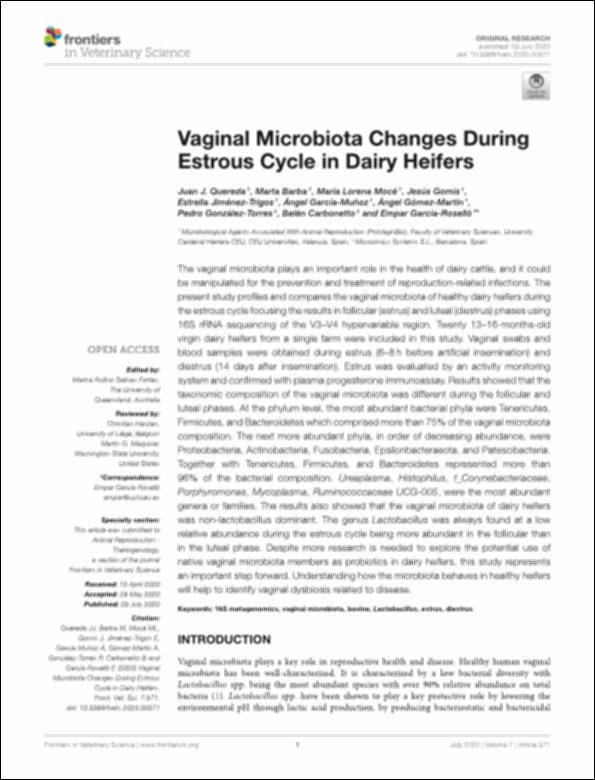Por favor, use este identificador para citar o enlazar este ítem:
http://hdl.handle.net/10637/12581Vaginal microbiota changes during estrous cycle in dairy heifers
| Título : | Vaginal microbiota changes during estrous cycle in dairy heifers |
| Autor : | Quereda Torres, Juan José Barba Recreo, Marta Mocé Cervera, María Lorena Gomis Almendro, Jesús Jiménez Trigos, María Estrella García Muñoz, Ángel Gómez Martín, Ángel García Roselló, Empar |
| Materias: | Ganado vacuno lechero - Reproducción.; Dairy cattle - Generative organs.; Dairy cattle - Reproduction.; Lactobacilos.; Ganado vacuno lechero - Aparato genital.; Bacteriología veterinaria.; Veterinary bacteriology.; Estrus.; Lactobacillus.; Estro. |
| Editorial : | Frontiers Media |
| Citación : | Quereda, J.J., Barba, M., Mocé, M.L., Gomis, J., Jiménez-Trigos, E., García-Muñoz, Á. et al. (2020). Vaginal microbiota changes during estrous cycle in dairy heifers. Frontiers in Veterinary Science, vol. 7, art. 371 (03 jul.). DOI: https://doi.org/10.3389/fvets.2020.00371 |
| Resumen : | The vaginal microbiota plays an important role in the health of dairy cattle, and it could be manipulated for the prevention and treatment of reproduction-related infections. The present study profiles and compares the vaginal microbiota of healthy dairy heifers during the estrous cycle focusing the results in follicular (estrus) and luteal (diestrus) phases using 16S rRNA sequencing of the V3–V4 hypervariable region. Twenty 13–16-months-old virgin dairy heifers from a single farm were included in this study. Vaginal swabs and blood samples were obtained during estrus (6–8 h before artificial insemination) and diestrus (14 days after insemination). Estrus was evaluated by an activity monitoring system and confirmed with plasma progesterone immunoassay. Results showed that the taxonomic composition of the vaginal microbiota was different during the follicular and luteal phases. At the phylum level, the most abundant bacterial phyla were Tenericutes, Firmicutes, and Bacteroidetes which comprised more than 75%of the vaginal microbiota composition. The next more abundant phyla, in order of decreasing abundance, were Proteobacteria, Actinobacteria, Fusobacteria, Epsilonbacteraeota, and Patescibacteria. Together with Tenericutes, Firmicutes, and Bacteroidetes represented more than 96% of the bacterial composition. Ureaplasma, Histophilus, f_Corynebacteriaceae, Porphyromonas, Mycoplasma, Ruminococcaceae UCG-005, were the most abundant genera or families. The results also showed that the vaginal microbiota of dairy heifers was non-lactobacillus dominant. The genus Lactobacillus was always found at a low relative abundance during the estrous cycle being more abundant in the follicular than in the luteal phase. Despite more research is needed to explore the potential use of native vaginal microbiota members as probiotics in dairy heifers, this study represents an important step forward. Understanding how the microbiota behaves in healthy heifers will help to identify vaginal dysbiosis related to disease. |
| Descripción : | Este artículo se encuentra disponible en la siguiente URL: https://www.frontiersin.org/articles/10.3389/fvets.2020.00371/full#h1 |
| URI : | http://hdl.handle.net/10637/12581 |
| Derechos: | http://creativecommons.org/licenses/by/4.0/deed.es |
| ISSN : | 2297-1769 (Electrónico). |
| Fecha de publicación : | 3-jul-2020 |
| Centro : | Universidad Cardenal Herrera-CEU |
| Aparece en las colecciones: | Dpto. Producción y Sanidad Animal, Salud Pública Veterinaria y Ciencia y Tecnología de los Alimentos |
Los ítems de DSpace están protegidos por copyright, con todos los derechos reservados, a menos que se indique lo contrario.


